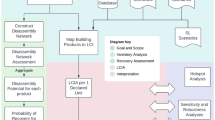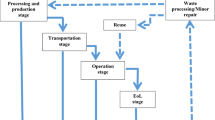Abstract
Purpose
Life cycle assessment (LCA) is generally considered as a suitable methodology for the evaluation of environmental impacts of processes. However, it requires large amount and often inaccessible process data at early design stages. The present study provides an approach to streamline LCA for a broad set of biomass process chains. The proposed method breaks away from conventional LCA work in that the purpose is to support decision at early stages assuming minimal use of data available and points to most dominant LCA impacts, providing useful feedback to process design.
Methods
The prediction mechanism employs decision trees, which form “if-then rules” using a set of critical parameters of the process chain with respect to various environmental impacts. The models classify products into three classes, namely having low, medium, and high environmental impact. Data for model development were obtained from early design stages and include descriptors of the molecular structure of the product and process chain-related variables corresponding to chemistry, complexity, and generic process conditions. Twenty-three LCA metrics were selected as target attributes, according to the ReCiPe and the cumulative energy demand (CED) methods. A broad set of process chains is derived from the work of Karka et al. (Int J Life Cycle Assess 22(9):1418–1440, 2017).
Results and discussion
Results demonstrate that the average classification error for the decision trees ranges between 13.4 and 43.8% for the various LCA metrics and multifunctionality approaches. Allocation approaches present a better classification performance (up to 25% error) compared with the substitution approach for LCA metrics, such as climate change, CED, and human health. For the majority of models, low- and high-output classes are characterized by better predictive performance compared with the medium class. The interpretability of selected decision trees is analyzed in terms of pruning levels and “irrational” branches. The results of the application of the decision tress for recently published case studies show for instance that 8 out of 13 cases were correctly classified for CED.
Conclusions
The proposed approach provides a first generation of models in the form of computationally inexpensive and easily interpretable decision trees that can be used as pre-screening tools for the environmental assessment of bio-based production ahead of detailed design and conventional LCA approaches. The transparent structure of the decision trees facilitates the identification of critical decision variables providing insights for improvement in terms of process parameters, biomass feedstock, or even targeted product.











Similar content being viewed by others
References
Albrecht T, Papadokonstantakis S, Sugiyama H, Hungerbühler K (2010) Demonstrating multi-objective screening of chemical batch process alternatives during early design phases. Chem Eng Res Des 88:529–550
Anastas PT, Warner JC (1998) Green chemistry: theory and practice. Oxford University Press, New York
Anastas P, Zimmerman J (2003) Design through the 12 principles of green engineering. Environ Sci Technol 37(5):94A–101A. https://doi.org/10.1021/es032373g
Azapagic A, Perdan S (2000) Indicators of sustainable developement for industry: a general framework. Proc Saf Environ Prot 78:243–261
Bare J, Norris A, Pennington W (2002) Traci. J Ind Ecol 6:49–78
BIOCORE, Final Report (2014) BIOCORE, final publishable summary report. BIOCORE
Blok K, Huijbregts M, Roes L, van Haaster B, Patel M, Hertwich E, Harmelink M (2013) A novel methodology for the sustainability impact assessment of new technologies. Utrecht. Retrieved March 1, 2018, from http://www.prosuite.org/c/document_library/get_file?uuid=bdbb04e9-1a34-434b-85a8-44bafb28155b&groupId=10136
Breiman L, Friedman J, Olshen R, Stone C (1984) Classification and regression tree. Pacific California
Broeren ML, Zijp MC, Waaijers-van der Loop SL, Heugens EH, Posthuma L, Worrell E, Shen L (2017) Environmental assessment of bio-based chemicals in early-stage development: a review of methods and indicators. Biofuels Bioprod Biorefin 11:701–718
Cespi D, Passarini F, Vassura I, Cavani F (2016) Butadiene from biomass, a life cycle perspective to address sustainability in the chemical industry. Green Chem 18:1625–1638
Cherubini F (2010) The biorefinery concept: using biomass instead of oil for producing energy and chemicals. Energy Convers Manag 51:1412–1421
Constable DJ, Curzons AD, Cunningham VL (2002) Metrics to ‘green’ chemistry—which are the best? Green Chem 4:521527
Curzons AD, Constable DJ, Mortimer DN, Cunningham VL (2001) So you think your process is green, how do you know?—using principles of sustainability to determine what is green—a corporate perspective. Green Chem 3:1–6
De Benedetto L, Klemes J (2009) The Environmental Performance Strategy Map: an integrated LCA approach to support the strategic decision-making process. J Clean Prod 17:900–906
Delen D, Walker G, Kadam A (2005) Predicting breast cancer survivability: a comparison of three data mining methods. Artif Intell Med 34:113–127
Diwekar UM (2003) Greener by design. Environ Sci Technol 37:5432–5444
Eckelman M (2016) Life cycle inherent toxicity: a novel LCA-based algorithm for evaluating chemical synthesis pathways. Green Chem 18:3257–3264
Fawcett T (2006) An introduction to ROC analysis. Pattern Recogn Lett 27:861–874
García-Serna J, Pérez-Barrigón L, Cocero M (2007) New trends for design towards sustainability in chemical engineering: green engineering. Chem Eng J 133:7–30
Goedkoop M, Heijungs R, Huijbregts M, De Schryver A, Struijs J, van Zelm R (2009) ReCiPe 2008.Alife cycle impact assessment method which comprises harmonised category indicators at the midpoint and the endpoint level. Report I: characterisation. Ministerie van Volkshuisvesting. Ruimtleijke Ordening en Milieubeheer
Gonzalez MA, Smith RL (2003) A methodology to evaluate process sustainability. Environ Prog 22(4):269–276
Guinée J (2001) Life cycle assessment: an operational guide to the ISO standards. Center of Environmental Science—Leiden University (CML), The Netherlands
Hunt R, Boguski T, Weitz K, Sharma A (1998) Case studies examining LCA streamlining techniques. Int J Life Cycle Assess 3:36–42
IChemE (2002) The sustainability metrics. Sustainable development progress metrics recommended for use in the process industries. IChemE, Rugby
IEA Bioenergy Task 42 (2013) Bio-based chemicals, value added products from biorefineries, Task 42 Biorefinery. Retrieved March 1, 2018, from http://www.iea-bioenergy.task42-biorefineries.com/en/ieabiorefinery.htm
Karka P, Papadokonstantakis S, Hungerbühler K, Kokossis A (2014) Environmental impact assessment of biorefinery products using life cycle analysis. In: Mario Eden JD (ed) Proceedings of the 8th International Conference on Foundations of Computer-Aided Process Design—FOCAPD. Cle Elum, Washington, USA
Karka P, Papadokonstantakis S, Kokossis A (2017) Cradle-to-gate assessment of environmental impacts for a broad set of biomass-to-product process chains. Int J Life Cycle Assess 22(9):1418–1440
Kokossis AC, Yang A, Tsakalova M, Lin T-C (2013) Systematic screening of multiple processing paths in biorefineries: the ABC (assessing biomass to chemicals) project and its potential to build process synthesis capabilities. In: Stuart PR, El-Halwagi MM (eds) Integrated biorefineries. Design, analysis and optimization. CRC Press, Taylor & Francis Group, Boca Raton, pp 37–58
Kokossis AC, Tsakalova M, Pyrgakis K (2015) Design of integrated biorefineries. Comput Chem Eng 81:40–56
Lari GΜ, Mondelli C, Papadokonstantakis S, Morales M, Hungerbühler K, Pérez-Ramírez J (2016) Environmental and economic assessment of glycerol oxidation to dihydroxyacetone over technical iron zeolite catalysts. React Chem Eng 1:106–118
McDonough W, Braugart M, Anastas PT (2003) Applying the principles of green engineering to cradle-to-cradle design. Environ Sci Technol 37(23):434A–441A
Morales M, Dapsens PY, Giovinazzo I, Witte J, Mondelli C, Papadokonstantakis S, Pérez-Ramírez J (2015) Environmental and economic assessment of lactic acid production from glycerol using cascade bio and chemocatalysis. Energy Environ Sci 8:558–567
Morales M, Ataman M, Badr S, Linster S, Kourlimpinis I, Papadokonstantakis S, Hungerbuhler K (2016) Sustainability assessment of succinic acid production technologies from biomass using metabolic engineering. Energy Environ Sci 9:2794–2805
Moreau V, Bage G, Marcotte D, Samson R (2012) Statistical estimation of missing data in life cycle inventory: an application to hydroelectric power plants. J Clean Prod 37:335–341
Patel AD, Meesters K, den Uil H, de Jong E, Blok K, Patel MK (2012) Sustainability assessment of novel chemical processes at early stage: application to biobased processes. Energy Environ Sci 5:8430–8444
Posada JA, Patel AD, Roes A, Blok K, Faaij AP, Patel MK (2013) Potential of bioethanol as a chemical building block for biorefineries: preliminary sustainability assessment of 12 bioethanol-based products. Bioresour Technol 135:490–499
PRé (2015) SimaPro database. Manual methods library. Retrieved March 1, 2018, from www.pre-sustainability.com
Ramezankhani A, Pournik O, Shahrabi J, Khalili D, Azizi F, Hadaegh F (2014) Applying decision tree for identification of a low risk population for type 2 diabetes. Tehran Lipid and Glucose Study. Diabetes Res Clin Pract 105:391–398
Ruiz-Mercado GJ, Smith RL, Gonzalez MA (2012a) Sustainability indicators for chemical processes: I. Taxonomy. Ind Eng Chem Res 51:2309–2328
Ruiz-Mercado GJ, Smith RL, Gonzalez MA (2012b) Sustainability indicators for chemical processes: II. Data needs. Ind Eng Chem Res 51(5):2329–2353
Saling P, Kicherer A, Dittrich-Krämer B, Wittlinger R, Zombik W, Schmidt I, Schmidt S (2002) Eco-efficiency analysis by BASF: the method. Int J Life Cycle Assess 7(4):203–218
Schmitz G, Aldrich C, Gouws FS (1999) ANN-DT: an algorithm for extraction of decision trees from artificial neural networks. IEEE Trans Neural Netw 10(6):1392–1401
Schulz M, Short M, Peters G (2012) A streamlined sustainability assessment tool for improved decision making in the urban water industry. Integr Environ Assess Manag 8:183–193
Sokolova M, Lapalme G (2009) A systematic analysis of performance measures for classification tasks. Inf Process Manag 45:427–437
Sugiyama H, Fischer U, Hungerbühler K (2008) Decision framework for chemical process design including different stages of environmental, health, and safety assessment. AICHE J 54(4):1037–1053
Tayefi M, Esmaeili H, Karimian MS, Zadeh AA, Ebrahimi M, Safarian M, Ghayour-Mobarhan M (2017) The application of a decision tree to establish the parameters associated with hypertension. Comput Methods Prog Biomed 139:83–91
The Biocore Project (2007–2013) The Biocore Project. Retrieved March 1, 2018, from The Biocore Project: http://www.biocore-europe.org/
Tsakalova M, Lin T-C, Yang A, Kokossis AC (2015) A decision support environment for the high-throughputmodel-based screening and integration of biomass processing paths. Ind Crop Prod 75:103–113
Tula A, Babi D, Bottlaender J, Eden M, Gani R (2017) A computer-aided software tool for sustainable process synthesis-intensification. Comput Chem Eng 105:74–95
Van Aken K, Strekowski L, Patiny L (2006) EcoScale, a semi-quantitative tool to select an organic preparation based on economical and ecological parameters. J Org Chem 2:3. https://doi.org/10.1186/1860-5397-2-3
Weidema B (2001) Avoiding co-product allocation in life cycle assessment. J Ind Ecol 4(3):11–33
Wernet G, Hellweg S, Fischer U, Papadokonstantakis S, Hungerbuhler K (2008) Molecular-structure-based models of chemical inventories using neural networks. Environ Sci Technol 42(17):6717–6722
Wernet G, Papadokonstantakis S, Hellweg S, Hungerbühler K (2009) Bridging data gaps in environmental assessments: modeling impacts of fine and basic chemical production. Green Chem 11:1826–1831
Wernet G, Conradt S, Isenring HP, Jiménez-González C, Hungerbühler K (2010) Life cycle assessment of fine chemical production: a case study of pharmaceutical synthesis. Int J Life Cycle Assess 15:294–303
Weston N, Clift R, Holmes P, Basson L, White N (2011) Streamlined life cycle approaches for use at oil refineries and other large industrial facilities. Ind Eng Chem Res 50:1624–1636
Yan R, Ma Z, Zhao Y, Kokogiannakis G (2016) A decision tree based data-driven diagnostic strategy for airhandling units. Energy Build 133:37–45
Young DM, Cabezas H (1999) Designing sustainable processes with simulation: the waste reduction (WAR) algorithm. Comput Chem Eng 23(10):1477–1491
Young D, Scharp R, Cabezas H (2000) The waste reduction (WAR) algorithm: environmental impacts, energy consumption, and engineering economics. Waste Manag 20(8):605–615
Yu Z, Haghighat F, Fung BC, Yoshino H (2010) A decision tree method for building energy demand modeling. Energy Build 42:1637–1646
Funding
The authors would like to acknowledge financial support from the FP7 KBBE Grant BIOCORE (FP7-241566), Marie-Curie Grant RENESENG (ITN-607415), and the “AI4B: Accountable IT Infrastructures for Optimizing Supply Chains in Biomass Symbiotic Networks,” General Secretariat for Research and Technology—Hellenic Ministry of Education and Religious Affairs.
The research leading to these results has also received funding from the People Programme (Marie Curie Actions) of the European Union’s Seventh Framework Programme (FP7/2007-2013) under REA grant agreement n° 608743 and by Region Västra Götaland.
Author information
Authors and Affiliations
Corresponding author
Additional information
Responsible editor: Ivan Muñoz
Publisher’s note
Springer Nature remains neutral with regard to jurisdictional claims in published maps and institutional affiliations.
Electronic supplementary material
ESM 1
(DOCX 552 kb)
Rights and permissions
About this article
Cite this article
Karka, P., Papadokonstantakis, S. & Kokossis, A. Environmental impact assessment of biomass process chains at early design stages using decision trees. Int J Life Cycle Assess 24, 1675–1700 (2019). https://doi.org/10.1007/s11367-019-01591-0
Received:
Accepted:
Published:
Issue Date:
DOI: https://doi.org/10.1007/s11367-019-01591-0




